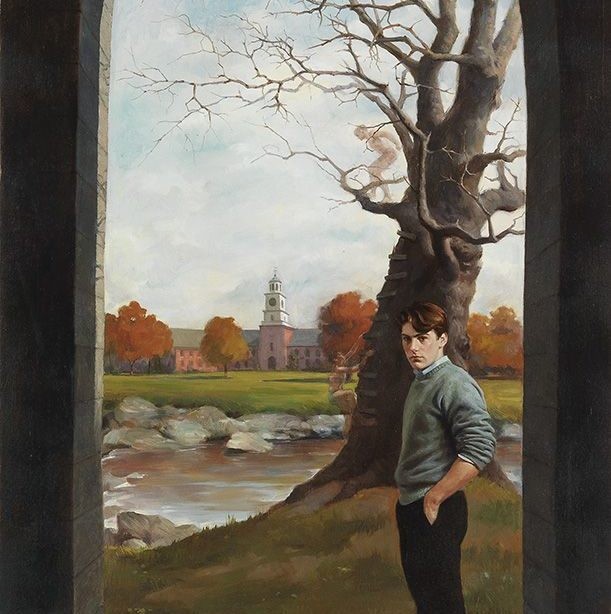A Separate Peace by John Knowles is a coming-of-age novel set against the backdrop of World War II, exploring the complexities of friendship, guilt, and the loss of innocence. This reading guide will delve into Chapters 1-4, uncovering the key themes and symbols that shape the narrative.
The Symbolic Fall from Innocence
I think it is the best-written, best-designed, and most moving novel I have read in many years. Beginning with a tiny incident among ordinary boys, it ends by being as deep and as big as evil itself.
– Aubrey Menen
The novel immediately introduces us to the central symbol: the tree. Gene Forrester, the narrator, returns to Devon School fifteen years after graduation, confronting a tree that evokes powerful memories.
Unbelievable that there were other trees which looked like it here. It had loomed in my memory as a huge lone spike dominating the riverbank, forbidding as an artillery piece, high as the beanstalk. Yet here was a scattered grove of trees, none of them of any particular grandeur.
The tree represents more than just a physical object; it symbolizes the loss of innocence and the transition from childhood to adulthood. Knowles masterfully employs war imagery, comparing the tree to an “artillery piece,” juxtaposed with the fairytale image of a “beanstalk.” This contrast highlights the precarious balance between the carefree world of youth and the looming realities of war and mortality. This A Separate Peace Reading Guide will illuminate how this symbol evolves throughout the novel.
The “small scars rising along its trunk” and its “weary from age” appearance indicate the enduring impact of the events that transpired beneath its branches. Gene’s initial reaction, “I was damned if I’d climb it,” underscores the tree’s connection to guilt, fear, and the potential for damnation.
Finny: Embodiment of Innocence and “A Separate Peace”
Finny is portrayed as the embodiment of innocence and joy, a stark contrast to Gene’s internal struggles. His “simple, shocking self-acceptance” and disregard for societal norms set him apart. He is an exceptional athlete, yet untouched by vanity or deceit.
Phineas just walked serenely on, or rather flowed on, rolling forward in his white sneakers with such unthinking unity of movement that “walk” didn’t describe it.
Finny’s character is closely tied to the concept of “a separate peace,” a state of being untouched by the anxieties and conflicts of the adult world. He exists in a realm of carefree joy, exemplified by his repeated jumps from the tree into the river. This a separate peace reading guide emphasizes the importance of Finny as a symbol.
The formation of the “Super Suicide Society of the Summer Session” (SSSotSS) highlights Finny’s influence and the allure of his carefree existence. However, the society’s name also foreshadows the darker events to come, hinting at the destructive potential within their seemingly innocent games.
The Seeds of Envy and Betrayal
Despite Finny’s seemingly unwavering goodness, Gene’s insecurities and competitive nature begin to fester. The incident where Finny saves Gene from falling from the tree becomes a turning point. While Gene acknowledges Finny’s heroism, he also harbors resentment: “Yes, he had practically saved my life. He had also practically lost it for me. I wouldn’t have been on that damn limb except for him.” This internal conflict reveals Gene’s inability to fully accept Finny’s altruism without suspicion. This a separate peace reading guide identifies this as a key moment.
The constant immersion in water – the river, the swimming meets, and the trip to the ocean – serves as both a source of joy and a reminder of Gene’s anxieties. While Finny revels in the freedom and exhilaration of the water, Gene experiences it as a threatening force.
The Climax: A Fall from Grace
The culmination of Gene’s internal turmoil occurs on the night of the SSSotSS initiation. As Finny confesses that he never realized Gene needed to study, Gene experiences a profound sense of isolation and inferiority. He realizes that Finny has never harbored any jealousy or rivalry towards him.
Faced with Finny’s genuine goodness, Gene’s impulsive heart acts:
Holding firmly to the trunk, I took a step toward him, and then my knees bent and I jounced the limb. Finny, his balance gone, swung his head around to look at me for an instant with extreme interest, and then he tumbled sideways, broke through the little branches below and hit the bank with a sickening, unnatural thud. It was the first clumsy physical action I had ever seen him make.
This act of betrayal marks a turning point in the novel. Finny’s physical fall from the tree mirrors Gene’s spiritual fall into darkness and guilt. Gene’s act of violence shatters the “separate peace” they had created and sets in motion a chain of events that will forever alter their lives.
Conclusion: Exploring Deeper Meaning
Chapters 1-4 of A Separate Peace establish the central themes of innocence, guilt, and the destructive nature of envy. The symbolic tree, the contrasting characters of Gene and Finny, and the recurring imagery of water contribute to the novel’s powerful exploration of the human condition. As this a separate peace reading guide has shown, the early chapters are crucial for understanding the tragic events that unfold. This reading guide provides a framework for understanding the complexities of A Separate Peace and encourages readers to delve deeper into its profound themes. The upcoming chapters promise further exploration of these themes, offering a poignant reflection on the loss of innocence and the enduring power of friendship. By studying key themes and symbols from the book such as peace, envy and innocence this a separate peace reading guide will enhance the readers understanding of the novel.

